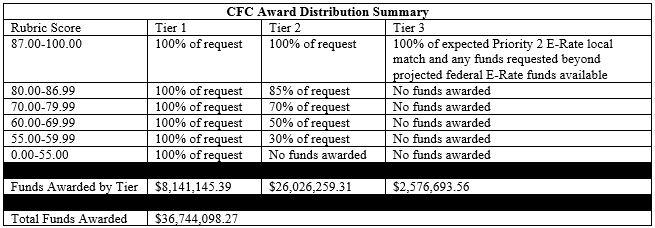
2014 CFC Grant Award Information
Overview
By summer 2015, every school district will receive increased bandwidth, equivalent to 100 Mbps per school, through the expansion of the University System of Georgia’s PeachNet. Connections for Classrooms provides grant awards to build out district- and school-level infrastructure equipment needed to ensure that schools can fully utilize that connectivity.
In October 2014, the Governor’s Office of Student Achievement (GOSA) and the Georgia Department of Education (GaDOE) released $37 million in Connection for Classrooms grant awards to local education authorities. 146 local education authorities—143 districts, 2 state charter schools, and 1 state school—applied for more than $198 million. 104 local education authorities (102 districts, 1 state charter school, and 1 state school) were awarded a total of $37 million. [1] The 2014 program primarily focused on purchasing equipment needed to ensure the increased bandwidth reaches classrooms (e.g., firewalls, routers, filters, cabling, ports, WAN, LAN, and wireless access points).
The program combined money from the following two fund sources: $14 million in bond funds from the GaDOE and $25 million in funds from the One Georgia Authority at the Department of Community Affairs (DCA), which GOSA manages.
The grant application window lasted from June 16, 2014 to September 4, 2014. In addition to detailing their technology expansion plans, applicants had to spell out how these grant awards would enable them to implement digital and blended learning, improve student achievement, and align with the recommendations of Gov. Deal’s Digital Learning Task Force. 146 local education authorities—143 districts, 2 state charter schools, and 1 state school—applied for more than $198 million.
Review Process
Each application was scored by four independent reviewers, two technical and two educational, using the rubrics previously published. Each rubric was worth 50 points. The two reviews of each type were averaged and added together for a total possible score of 100. Any technical or educational review that resulted in more than a 10-point spread between reviewers triggered a third review; that third score was averaged with the other two scores. LEAs were then ranked by total score.
Balancing the limited funds, the grant priorities, and the rubric scores, GaDOE and GOSA split funds between Tiers 1, 2 and 3 using the percentages in the table below. All Tier 1 requests were fulfilled regardless of application score to ensure that each LEA at least had the ability to receive and utilize the increased bandwidth through the upcoming PeachNet expansion. Tier 2 funding, as the next priority, was awarded at the level of the percentages listed below. Tier 3 funding was awarded to the 5 highest scoring applications, each of which received a score of 87 or higher. These LEAs received the full amount of the expected E-Rate Priority Two local match for their request as well as any Tier 3 funds requested above the amount of federal E-Rate funds available.
Grant Awards
104 local education authorities—102 districts, 1 state school, and 1 state charter school—received grant awards totaling just more than $36.7 million. The six highest scoring LEAs—Thomas, Peach, Tattnall, Ben Hill, Laurens, and Georgia School for the Deaf—will be able to fully fund Tiers 1 to 3 when grant funds are combined with expected Category 2 E-Rate funds. The grantees and award amounts can be downloaded below.
[1] Awards were revised on January 23, 2015 to account for a rubric scoring error that affected 13 applicants. Using the original scoring methodology, the adjusted score only resulted in award adjustments for 4 applicants. Of these, one additional grantee (Georgia School for the Deaf) received a grant award, and the remaining three grantees received increased award amounts (Douglas, Randolph, and Worth). All 13 applicants were notified of the scoring adjustment.